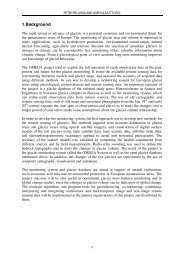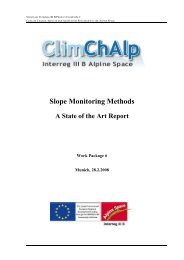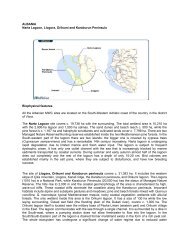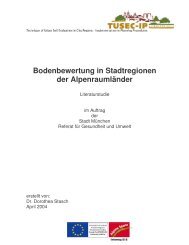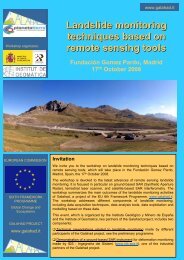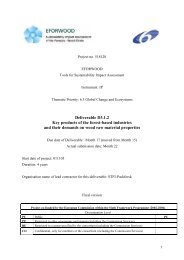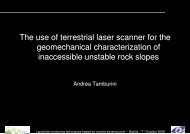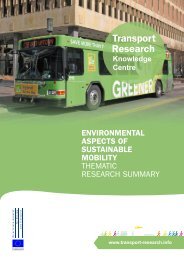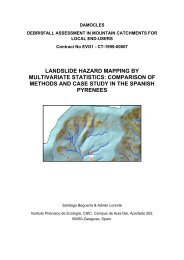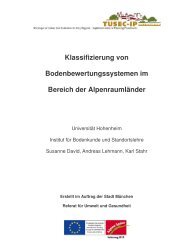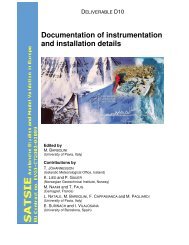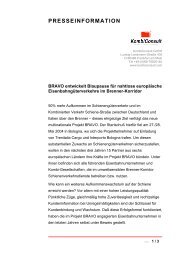Decision Support Tools - Thematic Research Summary - Transport ...
Decision Support Tools - Thematic Research Summary - Transport ...
Decision Support Tools - Thematic Research Summary - Transport ...
You also want an ePaper? Increase the reach of your titles
YUMPU automatically turns print PDFs into web optimized ePapers that Google loves.
also in cases where reasonable modal alternatives exist. Furthermore, transport operatorshave only limited information about the market potentials for integrated transport services,and significant deficiencies still exist in knowledge about current and potential intermodaldemand and supply. In this respect, research has developed and made available on theweb (http://ifv-kite.ifv.uni-karlsruhe.de/kite/wiki/) a Knowledge Base on intermodalpassenger travelling in Europe, which provides all relevant information about passengerintermodality, and allows stakeholders to develop and evaluate intermodality-relatedmeasures (KITE).Policy initiatives to improve vehicle safety, and consequently reduce the number ofcasualties and injuries, must be based on sufficiently detailed accident data to also supporttest procedure development. In order to harmonise accident data available at the nationallevel, the STAIRS project 6 has developed a standardised protocol for gathering in-depthaccident data relating to injuries of car passengers and pedestrians and has producedguidelines on statistical approaches required to develop a road accident database at theEuropean level. In addition, this research has addressed issues such as methods tocalculate collision severity, protocols to record the details of sustained injuries and thedevelopment of estimation methods to predict casualty reductions from new technologies(PENDANT, 2006), as well as developing the framework of the European Road SafetyObservatory (ERSO) (SafetyNet, 2009).As for methods to assess collision severity, guidelines for accident reconstruction havebeen produced, which provide an overview of methods for crash analysis, and a crash testdatabase has been developed (accessible at: www.crashtestdb.com) providing newaccess to EuroNCAP 7 and other crash test data. A review of the available injury scales hasidentified that the Abbreviated Injury Scale 8 is the most appropriate tool to describe thenature of injuries and measure threat to life. Furthermore, crash modelling methods havebeen used to predict changes in the typology of crashes and injuries resulting from the useof new technologies. Over 1100 crashes have been examined, gathering extensiveinformation about the nature of the collision (vehicle damage, performance of safetysystems and the sustained injuries). <strong>Research</strong> has also explored and demonstrated thepossibility of linking hospital data system to police data system and has analysed linkedaccident data to evaluate priorities in injury prevention and to identify issues related tounder-reporting of crashes (PENDANT, 2006).678STAIRS - Standardisation of Accident and Injury Registration Systems - FP4 -TRANSPORT RTD - <strong>Transport</strong> <strong>Research</strong> and Technological Development(www.transport-research.info)Euro NCAP provides motoring consumers - both drivers and the automotive industry -with a realistic and independent assessment of the safety performance of some of themost popular cars sold in Europe (source: www.euroncap.com).The Abbreviated Injury Scale is an internationally accepted tool for assessing andranking injury severity (www.aaam1.org/ais).<strong>Thematic</strong> <strong>Research</strong> <strong>Summary</strong>: “<strong>Decision</strong> <strong>Support</strong> <strong>Tools</strong>” Page: 36 of 74<strong>Transport</strong> <strong>Research</strong> Knowledge Centre




